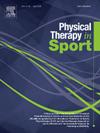落跳垂直动力学识别男性青少年足球运动员在非接触性膝盖损伤的风险较大
IF 2.2
3区 医学
Q1 REHABILITATION
引用次数: 0
摘要
目的探讨男性青少年足球运动员落跳垂直运动动力学与急性非接触性膝关节损伤风险之间的关系。前瞻性队列研究。设立专业足球学院。青少年足球运动员(n = 264)。主要观察指标:落跳垂直动力学;伤害流行病学。使用二元逻辑回归评估动力学和损伤之间的关联。采用统计参数映射法比较受伤组与未受伤组的差异。结果制动:峰值推进力比(OR = 1.59, 1.10-2.29, p <;0.05),推进工作(OR = 0.53, 0.28 - -0.99, p & lt;0.05)和垂直刚度(OR = 1.68, 1.13-2.52, p <;0.05)与持续膝盖损伤的风险相关。所有变量都显示出“不可用”或“弱”水平的预测能力,以确定哪些球员会受伤(AUC 0.568-0.663)。结论:表征力-时间波形形状的落跳垂直动力学为男性青少年足球运动员急性非接触性膝关节损伤风险提供了见解。在地面接触的早期阶段,力量的大瞬时峰值,加上推进力的减少,是男性青少年足球运动员急性非接触性膝盖损伤的危险因素。变量不够敏感,不足以预测伤害,但提供了额外的训练目标,以帮助减轻这一人群的风险。本文章由计算机程序翻译,如有差异,请以英文原文为准。
Drop jump vertical kinetics identify male youth soccer players at greater risk of non-contact knee injury
Objectives
To determine associations between drop-jump vertical kinetics and acute non-contact knee injury-risk in male youth soccer players.
Design
Prospective cohort study.
Setting
Professional soccer academies.
Participants
Youth soccer players (n = 264).
Main outcome measures
Drop-jump vertical kinetics; injury epidemiology. Associations between kinetics and injury were assessed using binary logistic regression. Differences between injured and uninjured groups were compared using statistical parametric mapping.
Results
Peak braking: peak propulsive force ratio (OR = 1.59, 1.10–2.29, p < 0.05), propulsive work (OR = 0.53, 0.28–0.99, p < 0.05) and vertical stiffness (OR = 1.68, 1.13–2.52, p < 0.05) were associated with risk of sustaining a knee injury. All variables demonstrated ‘unusable’ or ‘weak’ levels of predictive ability in identifying players who would become injured (AUC 0.568–0.663).
Conclusions
Drop-jump vertical kinetics that characterise the shape of the force-time waveform provide insight to acute non-contact knee injury-risk in male youth soccer players. Large transient spikes in force in the early phase of ground contact, coupled with reduced propulsive forces are a risk factor for acute non-contact knee injury in male youth soccer players. Variables are not sensitive enough to predict injury but provide additional training targets to help mitigate risk in this population.
求助全文
通过发布文献求助,成功后即可免费获取论文全文。
去求助
来源期刊

Physical Therapy in Sport
医学-康复医学
CiteScore
4.50
自引率
8.30%
发文量
125
审稿时长
39 days
期刊介绍:
Physical Therapy in Sport is an international peer-reviewed journal that provides a forum for the publication of research and clinical practice material relevant to the healthcare professions involved in sports and exercise medicine, and rehabilitation. The journal publishes material that is indispensable for day-to-day practice and continuing professional development. Physical Therapy in Sport covers topics dealing with the diagnosis, treatment, and prevention of injuries, as well as more general areas of sports and exercise medicine and related sports science.
The journal publishes original research, case studies, reviews, masterclasses, papers on clinical approaches, and book reviews, as well as occasional reports from conferences. Papers are double-blind peer-reviewed by our international advisory board and other international experts, and submissions from a broad range of disciplines are actively encouraged.
 求助内容:
求助内容: 应助结果提醒方式:
应助结果提醒方式:


